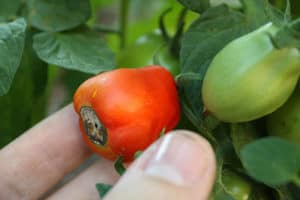Provide sufficient water to maximize calcium uptake to reduce blossom end rot in tomatoes, peppers and other vegetables
Blossom end rot (BER) causes unsightly and irreparable damage to millions of vegetables each year, resulting in costly post-harvest losses. At first glance, it is easy to conclude that this disorder is some type of fungi or bacteria, but the real culprit is lack of calcium.
Calcium is a building nutrient for vegetables and other plants; it links pectins and other structural compounds together for cell wall formation. Root damage, improper irrigation practices, extreme temperature variations, and highly acidic or alkaline soils all have the potential to inhibit calcium uptake.
“Blossom end rot initially occurs because of the rapid cell division and growth in young fruits, even temporary losses of calcium delivery to the site at this time can kill cells,” says Dr. Timothy Hartz, extension vegetable specialist for The University of California.
As the fruit continues to grow and expand, black or brown water-soaked lesions materialize near the blossom scar of the fruit. Tan-colored lesions, similar in appearance to sunscorch damage, appear on the blossom-half of peppers. Tip burn occurs on the new growth of lettuce and blackheart on new and mature celery. Secondary pathogens often invade the lesions and cause complete fruit loss.
Tomatoes, peppers, and some cucurbits are all prone to blossom end rot. In addition to these plants, growers also encounter calcium disorders in spinach, cauliflower and broccoli with some regularity. Vegetables that set fruit in a short amount of time, such as determinate tomato varieties, are especially susceptible to this disorder because they have a harder time regulating calcium intake.
Other Factors
“Two scenarios often occur when it comes to blossom end rot,” says Hartz. “One, the soil does not contain enough calcium to build cell walls, this is a rare situation. Two, you have an interruption of water availability due to dry soil. Therefore, the practical control of blossom end rot in both these commodities primarily goes to the issue of how you manage irrigation as opposed to how you manage the availability of calcium in the soil.” Hartz advises irrigation before the soil has expended more than 20% of available water content as a preventative measure.
“Additionally, if you apply heavy amounts of the ammonium (NH4) form of nitrogen, it can suppress calcium uptake and this also can be enough to cause blossom end rot,” says Hartz. “Be vigilant about this during the critical early fruit stage. Until the NH4 is changed into a nitrate (NO3) form by the soil microbes, it is in competition for calcium uptake and movement by plants.” To avoid this problem, Hartz recommends smaller applications of nitrogen for growers who use drip irrigation, no more than 20 to 25 pounds of nitrogen per acre, or use alternative forms of nitrogen until fruits are more mature.
Prevention
“The simple fact is that some amount of blossom end rot is inevitable,” says Hartz. “However, the catastrophic 15-25% amount of fruit damage can be avoided with proper irrigation and proper fertilization. Also, limit ammonium nitrate applications during that sensitive period of time when fruits are developing.”
KeyPlex’s micronutrient and biopesticide products are part art and part science – your source to unlock the complexity of plant health. KeyPlex offers several products that work well for fertility management. Check out KeyPlex’s crop KeyCards for more information.

